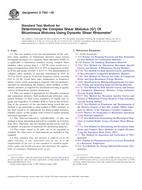Potřebujeme váš souhlas k využití jednotlivých dat, aby se vám mimo jiné mohly ukazovat informace týkající se vašich zájmů. Souhlas udělíte kliknutím na tlačítko „OK“.
ASTM D7552-09
Standard Test Method for Determining the Complex Shear Modulus (G*) Of Bituminous Mixtures Using Dynamic Shear Rheometer
Automaticky přeložený název:
Standardní zkušební metoda pro určeníComplex modul pružnosti ve smyku ( G * ) živičných směsí Použití Dynamic Shear Rheometer
NORMA vydána dne 1.7.2009
Informace o normě:
Označení normy: ASTM D7552-09
Poznámka: NEPLATNÁ
Datum vydání normy: 1.7.2009
Kód zboží: NS-38712
Počet stran: 11
Přibližná hmotnost: 33 g (0.07 liber)
Země: Americká technická norma
Kategorie: Technické normy ASTM
Anotace textu normy ASTM D7552-09 :
Keywords:
bituminous mixture, complex shear modulus, DSR, dynamic shear rheometer, torsion rectangular specimen, ICS Number Code 75.140 (Waxes, bituminous materials and other petroleum products), 91.100.50 (Binders. Sealing materials)
Doplňující informace
| Significance and Use | ||||||||||||||||||||||||||||||||
|
The complex shear modulus of bituminous mixtures is a fundamental property of the material. Test results at critical temperatures (Tcritical) are used for specifications for some mixes. Mixtures with stiffer binders, aged mixtures, mixtures with higher amounts of fines (material finer than 75µ), and mixtures with lower voids all tend to have higher complex shear modulus values than mixtures with less stiff binders, unaged mixes, mixtures with low levels of fines and higher air voids. In general, mixtures with higher complex shear modulus values at a given service temperature will exhibit lower permanent deformation values than similar mixtures tested at the same temperature that have lower complex shear modulus values. Note 2—The quality of the results produced by this standard are dependent on the competence of the personnel performing the procedure and the capability, calibration, and maintenance of the equipment used. Agencies that meet the criteria of Standard Practice D 3666 are generally considered capable of competent and objective testing/sampling/inspection/etc. Users of this standard are cautioned that compliance with D 3666 alone does not completely assure reliable results. Reliable results depend on many factors; following the suggestions of D 3666 or some similar acceptable guideline provides a means of evaluating and controlling some of those factors. |
||||||||||||||||||||||||||||||||
| 1. Scope | ||||||||||||||||||||||||||||||||
|
1.1 This test method covers the determination of the complex shear modulus of bituminous mixtures using torsion rectangular geometry on a dynamic shear rheometer (DSR). It is applicable to bituminous mixtures having complex shear modulus values greater than 1 × 104 Pa when tested over a range of temperatures from 10°C to 76°C at frequencies of 0.01 to 25 Hz and strains of 0.001 % to 0.1 %. The determination of complex shear modulus is typically determined at 20°C to 70°C at 0.01% strain at 10 discrete frequency values covering 0.01 to 10 Hz. From these data, temperature or frequency master curves can be generated as required. This test method is intended for determining the complex shear modulus of bituminous mixtures as required for specification testing or quality control of bituminous mixture production. 1.2 This test method is appropriate for laboratory prepared and compacted mixtures, field produced and laboratory compacted mixtures or field cores, regardless of binder type or grade and regardless of whether RAP is used in the mixture. Due to the geometry of the specimens being tested this test method is not applicable to open-graded or SMA mixtures. It has been found to be appropriate for dense-graded mixtures, whether coarse- or fine-graded, with 19 mm or smaller nominal maximum aggregate size. 1.3 The between-laboratory reproducibility of this test method is being determined and will be available on or before June 2012. Therefore, this test method should not be used for acceptance or rejection of materials for purchasing purposes. 1.4 The values stated in SI units are to be regarded as standard. No other units of measurement are included in this standard. 1.5 This standard does not purport to address all of the safety concerns, if any, associated with its use. It is the responsibility of the user of this standard to establish appropriate safety and health practices and determine the applicability of regulatory limitations prior to use. |
||||||||||||||||||||||||||||||||
| 2. Referenced Documents | ||||||||||||||||||||||||||||||||
|
Doporučujeme:
Aktualizace zákonů
Chcete mít jistotu o platnosti užívaných předpisů?
Nabízíme Vám řešení, abyste mohli používat stále platné (aktuální) legislativní předpisy.
Chcete vědět více informací? Podívejte se na tuto stránku.




 Cookies
Cookies
